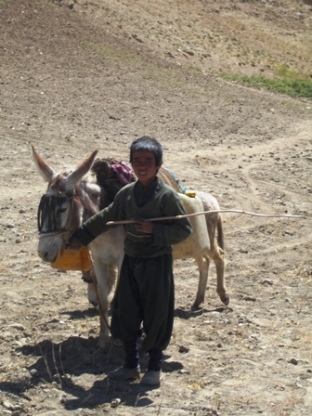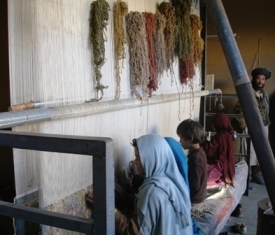
I saw this and I went ‘ahh.’

I saw this and I laughed at the incongruity of it.

I saw this, my body tensed and a voice inside my head cried ‘child labour!’
We had been talking with a man about his carpet weaving business when he invited us to his house. Before sitting down on expensive green carpets and being served tea and sweets, he showed us his work: a dimly lit room, one end filled with bundles of dyed wool while along one side a bench with two boys and three girls sat facing the wall, hands flickering as they twisted and wove the yarn. The youngest looked about five.
They were, he said over tea, his family. ‘Trainees,’ they only worked after school finished at noon. I felt a certain elusiveness in these answers. He was more precise on other matters. It would take his trainees four months to weave a 12 meter square carpet, three square meters a month, twice that if they worked full time. Whether or not the children would get fed or paid was not a question I felt able to ask.
But one question in particular has been bothering me since this encounter a week ago. Why was my reaction so strong when I see children working everyday and bat not an eyelid? Children herding flocks of sheep all day, girls washing clothes in frozen streams, boys carrying water or working in the fields. Is it just because these fit my own perception of rural life, while children of the same age working inside have a more sinister, workhouse light to them in my mind? Children outside: good and wholesome. Children inside: Oliver Twist or obese kids watching too much TV.
To my mind, the idea of ‘child labour’ – with its usual Western connotations – does not hold much water in Afghanistan. As in many parts of the world, the concept of ‘childhood’ does not have the same aura of sanctity that the Victorians pinned to it. Cultural relativity should not become an excuse for ignoring children’s rights, but children are expected to work and out of necessity may often have no choice.
However much I rationalised it, I still walked away feeling deeply uneasy. What concerned me with the carpet weavers was the possibility they were not child labourers but bonded labourers: ‘owned’ by the business man, working to pay off their families’ debt.
Or, they could be attending school while also learning a valuable practical skill, and in twenty years time their eyesight may be just fine.
Tags: Afghanistan, bonded labour, carpets, Child labour
Leave a comment